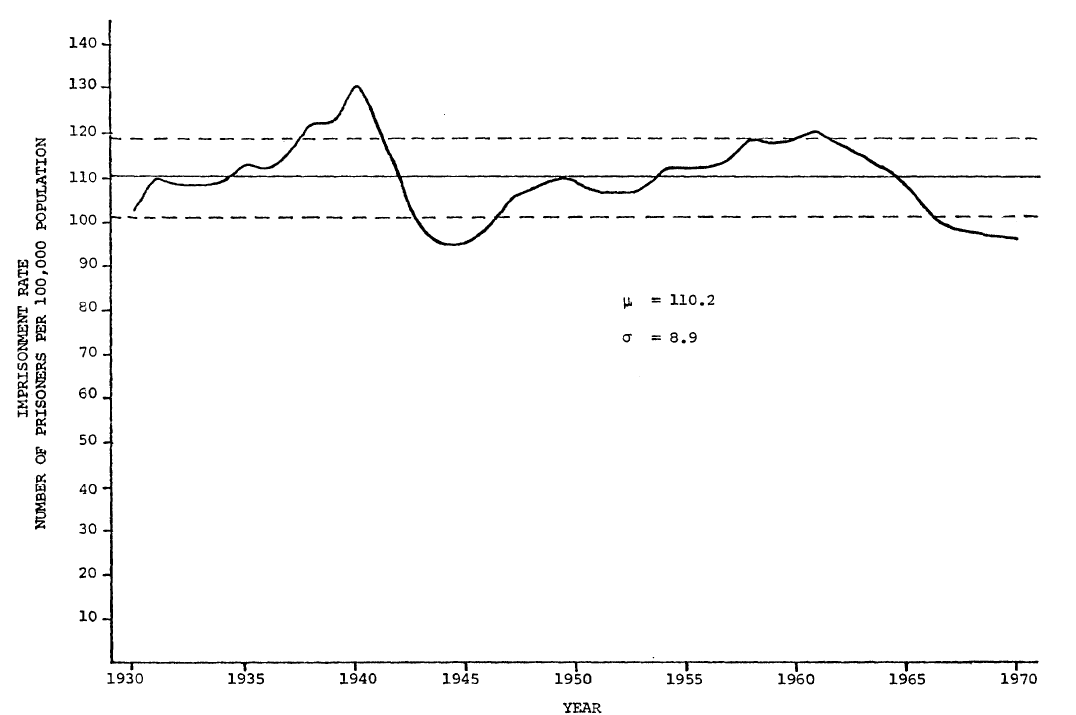Now is a great time to remind folks about how we released people in the past to keep the prison population under control. See this study by Shelly Messinger and his colleagues from 1985 about California.
https://www.jstor.org/stable/3053395?seq=1">https://www.jstor.org/stable/30...
https://www.jstor.org/stable/3053395?seq=1">https://www.jstor.org/stable/30...
This tweet (thread, perhaps) is inspired by @PrisonPolicy& #39;s great list of large scale releases in the past. https://www.prisonpolicy.org/blog/2020/04/09/large-scale-releases/">https://www.prisonpolicy.org/blog/2020...
Back in the early 1970s, criminologists began theorizing what they called the "stability of punishment." Our incarceration rate was stable for most of the 20th C, barring major events like the Depression or WWII. (This is right before mass incarceration started.)
The leading article on this topic was Blumstein and Cohen& #39;s (1973) piece. https://www.jstor.org/stable/1142990 ">https://www.jstor.org/stable/11...
The stability of punishment thesis was soundly disproven, first by Berk et al. (including Messinger) and later by mass incarceration. https://www.jstor.org/stable/2095080?seq=1">https://www.jstor.org/stable/20...
Why did incarceration rates appear so stable? Correctional officials and other CJ folks used a variety of mechanisms, including parole, to avoid overcrowding. Here& #39;s the big piece by Berk et al. (again with Messinger) from 1983. https://www.jstor.org/stable/3053488?seq=1">https://www.jstor.org/stable/30...
Why are we getting overcrowded prisons these days? In many states, parole was severely restricted or abolished. See @HeatherS_25& #39;s great study of Florida that includes a discussion on parole. https://www.press.uchicago.edu/ucp/books/book/chicago/B/bo27527318.html">https://www.press.uchicago.edu/ucp/books...
Additionally, parole changed forms, becoming more of a funneling system back into prisons, and less of a release valve. See @JonathanSimon59& #39;s Poor Discipline for the California story. https://www.press.uchicago.edu/ucp/books/book/chicago/P/bo3629579.html">https://www.press.uchicago.edu/ucp/books...
These changes, by the way, are part of a larger pattern that Simon and Malcolm Feeley wrote about for CJ more generally. https://onlinelibrary.wiley.com/doi/10.1111/j.1745-9125.1992.tb01112.x">https://onlinelibrary.wiley.com/doi/10.11...
Of course, the story isn& #39;t going to be the same across the country. A great indicator is @MichelleSPhelps& #39;s study of probation, showing that some places build up their community corrections and prison pops, but others build up one and not the other. https://journals.sagepub.com/doi/abs/10.1177/1462474516649174">https://journals.sagepub.com/doi/abs/1...
But it bears repeating how old the strategy of releasing prisoners early for administrative reasons (like overcrowding) is.
It happened in the 1860s in Pennsylvania when post-Civil War crowding made the prison admin at @easternstate, who were ideologically opposed to releases, change their mind (reversing their opposition to the 1861 commutation law). https://onlinelibrary.wiley.com/doi/full/10.1111/lsi.12263">https://onlinelibrary.wiley.com/doi/full/...
And I forgot to include the most spot-on piece by @CharlotteERosen which discusses a recent precedent of releasing PA prisoners early due to dangerous conditions. https://beltmag.com/catastrophe-prison-jails-covid-19-coronvirus/">https://beltmag.com/catastrop...
In terms of what this could do the crime rate, a great example is California& #39;s Realignment effort which resulted from an overcrowding-induced/exacerbated health care crisis. The cases are discussed in @JonathanSimon59& #39;s Mass Incarceration on Trial. https://www.amazon.com/Mass-Incarceration-Trial-Remarkable-Decision/dp/1620972549">https://www.amazon.com/Mass-Inca...
Numerous scholars have evaluated the apparent effect of the large-scale releases on California& #39;s crime rate. Here& #39;s a study by Magnus Lofstrom and Steve Raphael. The answer is no or very little effect on some types of crime. https://journals.sagepub.com/doi/abs/10.1177/0002716215599732">https://journals.sagepub.com/doi/abs/1...
Here& #39;s another study, also suggesting mostly no effect. https://onlinelibrary.wiley.com/doi/abs/10.1111/1745-9133.12199">https://onlinelibrary.wiley.com/doi/abs/1...

 Read on Twitter
Read on Twitter



